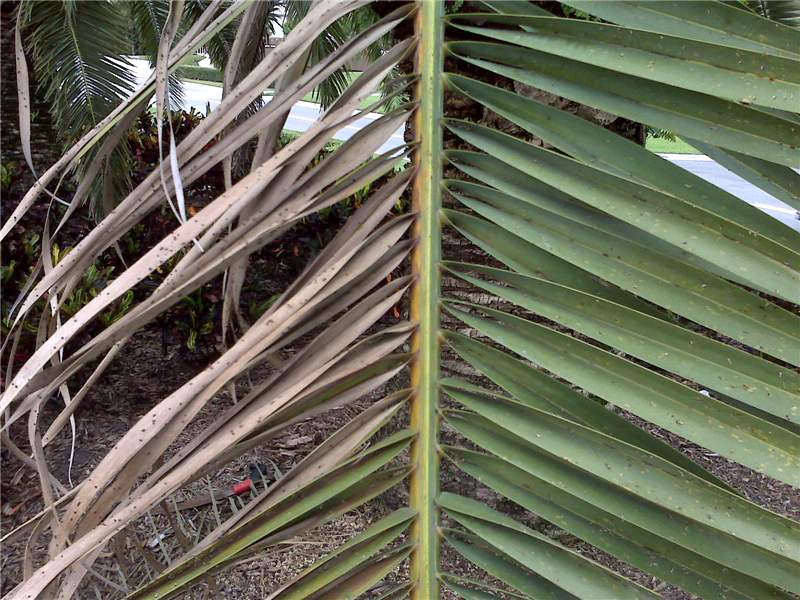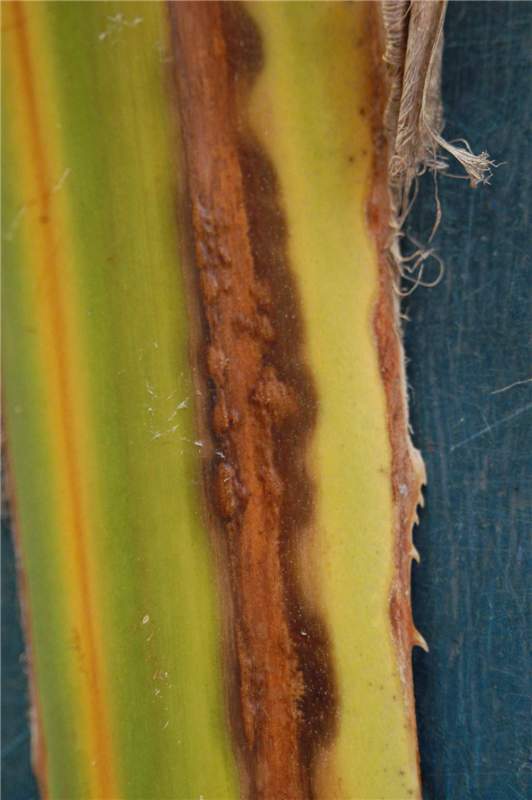Petiole (Rachis) Blight
|
Figure 2. Internal discoloration due to a petiole (rachis) blight pathogen. Photo by A. J. Downer
|
|
Figure 1. This Phoenix canariensis leaf has green leaflets on one side of the rachis and necrotic leaflets on the opposite side. There is a reddish-brown stripe on the rachis that corresponds to the necrotic leaflets. Photo by M. L. Elliott.
|
|
Figure 4. A single Washingtonia robusta leaf where a quarter of the leaf blade is still green, but the remaining leaf segments are necrotic. The petiole has a reddish-brown stripe on the same side where the necrotic leaf segments are located. Photo by M. L. Elliott.
|
|
Figure 3. Washingtonia robusta canopy with older leaves exhibiting leaf blades with mixture of healthy, chlorotic and necrotic leaflet segments. Photo by M. L. Elliott.
|
|
Figure 6. This petiole has a reddish-brown stripe that is accompanied by "blisters". The fungal pathogen is forming spore structures that will erupt through the epidermis. Photo by M. L. Elliott.
|
|
Figure 5. This Livistona chinensis leaf has a reddish-brown stripe on only one side of the petiole due to petiole blight. Part of the leaf blade is necrotic and the other portion is still green. Photo by M. L. Elliott.
|
|
Figure 7. The "bumps" are spore structures (pycnidia) of Dothiorella. In the center of the photo, you can observe spore masses emerging from the pycnidia. Photo by A. J. Downer.
|
Scientific name of pathogen
Cocoicola californica and Serenomyces spp. are considered the primary pathogens of petiolepetiole:
leaf stem
(rachis) blight. Diplodia, Dothiorella, Fusicoccum, Macrophoma, Phoma and Phomopsis have also been associated with symptoms of this disease. All of the pathogens belong to the Kingdom Fungi.
Hosts
Because there are a number of pathogens associated with this disease, all palms may be susceptible to at least one of the pathogens. Palms are the only known plant hosts for Cocoicola californica and Serenomyces spp., whereas the other pathogen species have multiple plant family hosts.
Distribution
In general, the pathogens are distributed worldwide, although individual species may have a limited geographic range.
Cocoicola californica has only been found in association with Washingtonia spp. in the USA (California, Florida).
Symptoms/signs
The term "petiolepetiole:
leaf stem
" refers to the portion of the leaf between the leaf baseleaf base:
the basal portion of a leaf petiole that is attached to the stem
and the leaf bladeleaf blade:
the broad, flattened distal portion of a leaf
. A palmatepalmate:
hand-like
leaf palm has only a petiolepetiole:
leaf stem
. The term "rachisrachis:
the axis of a leaf beyond the petiole or an extension of the petiole into the leaf blade
" refers to the extension of the petiolepetiole:
leaf stem
into the leaf bladeleaf blade:
the broad, flattened distal portion of a leaf
that the leaflets are attached to in a pinnatepinnate:
feather-like
leaf palm. The leaves of pinnatepinnate:
feather-like
leaf palms have both a petiolepetiole:
leaf stem
and a rachisrachis:
the axis of a leaf beyond the petiole or an extension of the petiole into the leaf blade
.
Initial symptoms normally occur on the lowest (oldest) living leaves in the canopycanopy:
the cluster of leaves borne at the tip of the stem
. For palms with pinnatepinnate:
feather-like
leaves, there will be at least one leaf with leaflets, either all of them or only a portion, on only one side of the rachisrachis:
the axis of a leaf beyond the petiole or an extension of the petiole into the leaf blade
that will be discolored, usually a shade of brown due to desiccation or death. The leaflets on the opposite side of the rachisrachis:
the axis of a leaf beyond the petiole or an extension of the petiole into the leaf blade
will be a healthy green color (Fig. 1). A reddish-brown or dark-brown stripe will be observed on the petiolepetiole:
leaf stem
and rachisrachis:
the axis of a leaf beyond the petiole or an extension of the petiole into the leaf blade
of the affected frond, on the same side where the first dead leaflets appear. This streak may run the full length of the petiolepetiole:
leaf stem
and rachisrachis:
the axis of a leaf beyond the petiole or an extension of the petiole into the leaf blade
, or just a portion of it. Internal discoloration will be observed in cross-sections of the discolored petiolepetiole:
leaf stem
and rachisrachis:
the axis of a leaf beyond the petiole or an extension of the petiole into the leaf blade
(Fig. 2). Eventually, the leaflets on the other side of the rachisrachis:
the axis of a leaf beyond the petiole or an extension of the petiole into the leaf blade
will turn brown also, and the entire leaf dies.
For palms with palmatepalmate:
hand-like
or costapalmatecostapalmate:
a leaf that is partially palmate and partially pinnate
leaves, there will be at least one leaf with a mixture of healthy, chloroticchlorotic:
see chlorosis
and necroticnecrotic:
see necrosis
leafletleaflet:
divisions of pinnate leaves
segments (Fig. 3). As with palms with pinnatepinnate:
feather-like
leaves, there will be a reddish-brown or dark-brown stripe on the petiolepetiole:
leaf stem
(Figs. 4 and 5), with a corresponding internal discoloration observed in cross-section.
The pathogens are found in the petiolepetiole:
leaf stem
or rachisrachis:
the axis of a leaf beyond the petiole or an extension of the petiole into the leaf blade
tissue, and not the leafletleaflet:
divisions of pinnate leaves
or leaf segmentleaf segment:
divisions of palmate and costapalmate leaves
tissue. Under high humidity situations, the pathogens will erupt through the epidermal tissue to expose fungal fruiting structures. These eruptions may look like blisters on the petiolepetiole:
leaf stem
(Fig. 6), or be very distinct, individual structures with spore masses emerging (Fig. 7).
May be confused with
For Phoenix canariensis, Syagrus romanzoffiana and Washingtonia robusta, Fusarium wilt causes the same symptoms as petiolepetiole:
leaf stem
(rachis) blight. Laboratory diagnosis is necessary to confirm which pathogen is responsible for the symptoms. It is possible for a Fusarium wilt pathogen and a petiolepetiole:
leaf stem
(rachis) blight pathogen to be present in the same tissue of these palm species.








